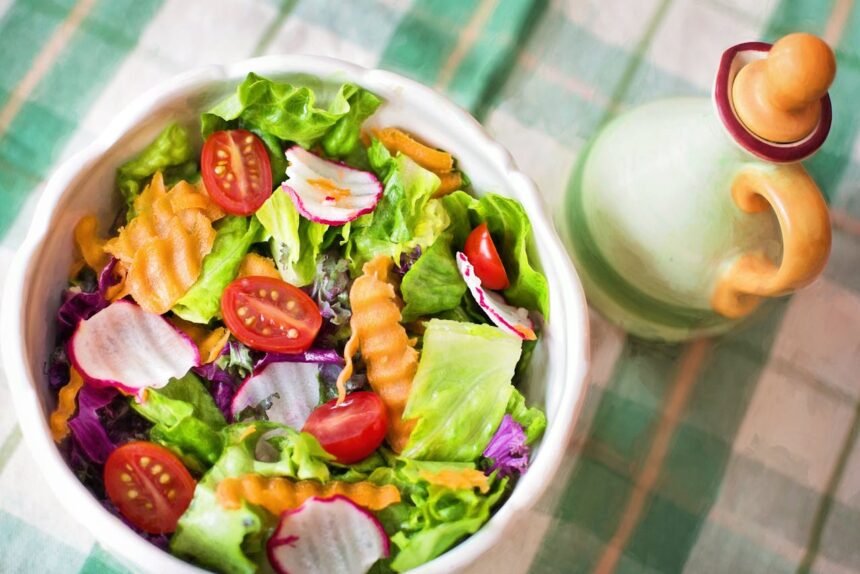Kickstart your summer with refreshing salads that support your weight goals. This guide provides simple, tasty recipes crafted to be both satisfying and low in calories. Embrace vibrant seasonal produce to create meals that feel indulgent without compromising on nutrition. Each section explores themes like flavour-packed dressings, smart ingredient swaps, and time-saving tips. Whether you’re new to healthy eating or seeking fresh ideas, these summer salad recipes make weight management feel like a breeze. Dive into crisp textures, zesty dressings, and colourful combinations that will keep you energised on warm days. Discover effortless approaches to salad prep and maintenance of a healthy lifestyle.
Why Summer Salads Aid Weight Management
Summer salads shine as an ideal weight-management tool because they centre on low-calorie, high-volume ingredients that keep you full longer. Fresh leafy greens such as rocket, spinach, and watercress deliver vital vitamins without excess energy. By emphasising hydrating produce—cucumber, watermelon, and tomato—you consume more satisfying bulk with fewer calories. Including lean proteins like grilled chicken, tuna, or chickpeas balances macro-nutrients for muscle support. Healthy fats from avocado, olives, or nuts improve nutrient absorption and impart richness, preventing cravings. By leveraging seasonal abundance, you gain maximum flavour, minimise processed components, and streamline meal prep—key factors in sustainable weight control.
Core Ingredients for Vibrant Summer Salads
Freshness matters when crafting summer salads. Start with a crisp base—lettuce, kale, or endive—and layer in textures like radish, pepper, or carrot to boost crunch. Bright fruits such as mango, pineapple, or strawberries introduce natural sweetness, while feta, halloumi, or mozzarella add creamy depth. Herbs like basil, mint, and coriander infuse aromatic complexity. For extra protein and fibre, consider quinoa, lentils, or edamame. Drizzle light dressings centred on olive oil, apple cider vinegar, or citrus juice to tie flavours together. Embracing regional UK produce—English asparagus, garden peas, and courgette—keeps your salad inspiring and aligns with local seasonality.
Simple Dressings to Elevate Flavours
Homemade dressings transform humble salads into gourmet experiences. A classic lemon-and-honey vinaigrette uses freshly squeezed lemon juice, Dijon mustard, honey, and extra virgin olive oil, whisked until emulsified. For creamier profiles, blend Greek yoghurt, cucumber, garlic, and dill. A balsamic reduction with maple syrup adds sweet-tart intensity. Spice fans can mix harissa paste, lemon, and olive oil for a North African twist. All dressings can be prepared in advance and stored in jars, making weekday lunches effortless. Opt for minimal salt, balanced acids, and quality oils to keep calories in check while maximising taste.
Recipe: Watermelon, Feta & Mint Salad
This crisp salad energises with hydrating watermelon, tangy feta, and cooling mint. Cube 300g of seedless watermelon, crumble 100g of feta cheese, and finely chop a handful of fresh mint. Toss with a drizzle of lime juice, 1 tablespoon of extra virgin olive oil, and a pinch of sea salt. Add thin slices of red onion for bite. Serve immediately, garnished with microgreens. This dish offers 150–200 calories per serving, rich in hydration, protein, and antioxidants. Ideal for poolside or picnic, it’s both a palate cleanser and a satisfying snack when the mercury rises.
Recipe: Classic Niçoise with a Healthy Twist
Reinvent the traditional Niçoise using steamed green beans and new potatoes. Combine 100g new potatoes, boiled and quartered, with 80g steamed green beans. Flake 120g canned tuna in spring water. Halve 10 cherry tomatoes and add 2 boiled eggs, quartered. Mix in olives, capers, and chopped parsley. Dress with a mustard-anchored vinaigrette (1 teaspoon Dijon, 1 tablespoon white wine vinegar, 2 tablespoons olive oil). Season with black pepper. This balanced plate contains high-quality protein, healthy fats, and complex carbs—an excellent option for lunch or light dinner.

Recipe: Chickpea, Avocado & Tomato Mélange
Combine one drained tin of chickpeas with a diced ripe avocado, 150g chopped cherry tomatoes, and a handful of baby spinach. Scatter slivered red onion and chopped coriander leaves. Drizzle with a coriander-lime dressing: blend juice of one lime with a small handful of coriander, 1 tablespoon of olive oil, and a clove of garlic. Season to taste. This vegan-friendly salad offers 12g fibre per serving, supporting digestive health and satiety, while healthy monounsaturated fats help maintain stable energy.
Recipe: Greek Quinoa & Cucumber Salad
Cook 100g quinoa according to packet instructions, cool, then combine with diced cucumber, halved kalamata olives, chopped red pepper, and crumbled feta. Stir through chopped oregano, a splash of red wine vinegar, and 2 tablespoons of extra virgin olive oil. Season with cracked black pepper. Quinoa’s complete protein profile and fibre-rich vegetables make this salad a filling, gluten-free staple. Enjoy it chilled, garnished with lemon zest.
Salad Prep Hacks for Busy Schedules
Effortless salad prep relies on smart strategies. Wash and spin-dry leafy greens immediately upon shopping to save time later. Pre-chop vegetables and store in airtight containers, layering hard produce at the bottom and tender leaves on top. Keep dressings separate until serving to prevent sogginess. Use multi-compartment meal boxes for grab-and-go lunches. Freeze ice-cube trays of olive oil combined with herbs or lemon juice for quick dressing portions. Store protein—grilled chicken strips, canned beans, or boiled eggs—in clear containers at eye level. Weekly batch prep reduces daily effort and ensures healthy options remain accessible.
Incorporating Superfoods into Salads
Boost nutritional value by adding superfoods like chia seeds, hemp hearts, and goji berries. Sprinkle flaxseed for omega-3 support and fibre. Toss in spirulina powder within creamy dressings for a vibrant green hue and powerful antioxidants. Include pumpkin seeds or almond slivers for zinc and vitamin E. These additions require minimal volume but deliver substantial micro-nutrients, aiding metabolism and immune function—key factors in sustainable weight management.
Seasonal Variations for UK Summers
Adapt salads to seasonal harvests. In June, incorporate English asparagus spears and broad beans. July calls for soft-fruit like raspberries and redcurrants. August features sweetcorn and beetroot, while early September sees apples and squash making an appearance. Rotating ingredients not only maintains excitement but also provides a diverse nutrient intake across the growing season, crucial for balanced health and effective weight control.
Pairing Salads with Balanced Meals
Enhance your salad’s staying power by pairing with fibre-rich sides like wholemeal breadsticks or seeded crackers. Complement with a bowl of vegetable soup or a small portion of whole-grain pasta tossed in olive oil and garlic. For protein-focused meals, serve alongside grilled fish, tofu skewers, or lean turkey breast. Thoughtful pairings ensure sustained energy, prevent mid-afternoon cravings, and create well-rounded plates for effortless calorie control.
Tips for Mindful Eating
Mindful eating promotes awareness of hunger cues and reduces overeating. Sit down without distractions—no screens—focus on colours, textures, and flavours. Chew slowly, savouring each bite, and put down utensils between mouthfuls. This practice encourages better digestion and satisfaction with smaller portions. Portion out salads into bowls rather than eating from large sharing platters to maintain control. Drinking a glass of water before eating can also aid fullness, supporting weight management goals.
Similar Resources and Further Reading
Explore additional inspiration and guidance on healthy summer salads from reputable sites:
- BBC Good Food: https://www.bbcgoodfood.com/recipes/category/salads
- Delicious Magazine: https://www.deliciousmagazine.co.uk/recipes/salads/
- Olive Magazine: https://www.olivemagazine.com/recipes/salad/
Each offers a wealth of recipes and seasonal tips for fuss-free cooking.
Frequently Asked Questions
Q: Can I prepare salads ahead for the entire week?
Yes. Prep greens and proteins separately, store dressings in jars, and assemble just before eating to prevent sogginess.
Q: How do I keep avocados from browning?
Brush cut surfaces with lemon or lime juice and store in an airtight container with a slice of onion to slow oxidation.
Q: Are salad dressings high in calories?
They can be. Use measured amounts of oil, focus on vinegar or citrus bases, and dilute rich dressings with low-fat yoghurt or water.
Q: Can I add fruit to savoury salads?
Absolutely. Fruits like berries, melon, and apples introduce natural sweetness, complement savoury ingredients, and boost hydration.
Q: What’s the best protein for vegan salads?
Chickpeas, lentils, tofu, edamame, and quinoa are excellent vegan protein sources, offering complete amino acid profiles when combined.






